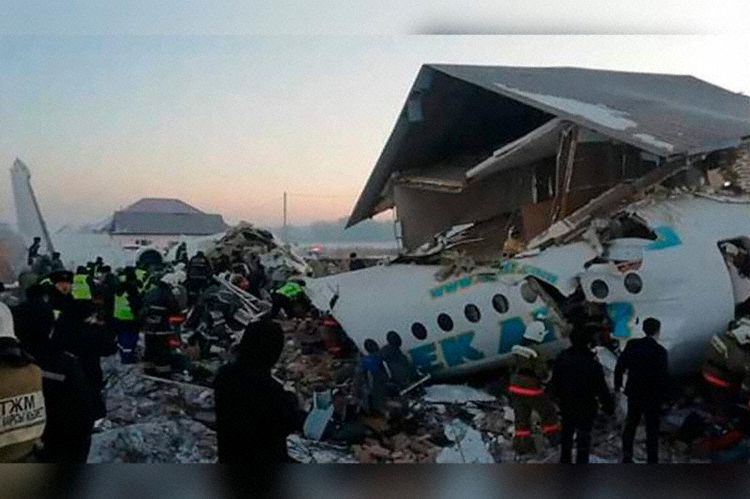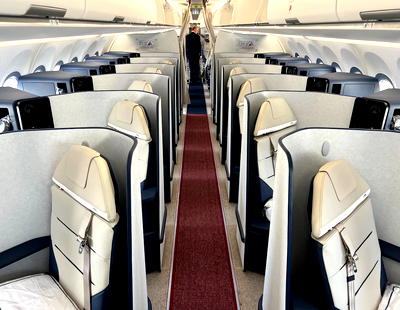Well this is just awful…
Bek Air Fokker 100 Crashes In Almaty
This morning a Bek Air Fokker 100 scheduled to operate the ~600 mile domestic flight from Almaty to Nur-Sultan, Kazakhstan, crashed shortly after takeoff. The plane had about 98 people onboard, including 93 passengers and five crew (note that there are still some minor inconsistencies regarding this).
The plane took off from Almaty’s runway 5R (this is over 14,000 feet long) at around 7:21AM this morning, but failed to gain altitude, and broke through a concrete fence shortly after departure. No fire broke out, but the plane broke into several sections.
There are inconsistent reports as to how many people died and were injured, with most reports suggesting that 12 people have died, and 66 were initially taken to the hospital, with an additional 12 (or so) people being in critical condition.
The captain was 58 years old and died in the crash, while the first officer was 54 years old, and has suffered serious injuries.
I’m sure we’ll have more information soon.

What Is Bek Air?
For those of you not familiar with Bek Air, they’re a Kazakh airline that operates a fleet of eight Fokker 100s, so this is the only type of plane they fly. Kazakhstan’s Civil Aviation Authority has suspended the Air Operator’s Certificate of Bek Air following the incident, and Fokker 100s are also grounded in the country.
The Fokker 100 involved in the incident had been in service since 1996, so was about 23 years old.
What We Know About The Plane Crash
Again, there are still inconsistent reports as to what exactly happened. Kazakhstan’s Deputy Prime Minister initially reported that the aircraft struck its tail on the runway twice, with a distance of about 300-400 meters between the strikes.
Then at the end of the runway, the plane turned sharply right, and then with the landing gear retracted the plane failed to gain altitude. It would appear that the plane never gained more than 100 feet of altitude, at most.
The plane came to a stop to the right of the end of the runway.
Currently they’re investigating if there was a technical fault or pilot error, or what could have caused this. Runway conditions were good, though it’s noted that frost had developed on the wings of some planes due to ice. It’s not known if that was a factor here.
Bottom Line
It’s heartbreaking to see a fatal plane crash like this, especially with a dozen or more fatalities. Hopefully an investigation is carried out to ensure something like this never happens again.
My thoughts are with those onboard and their families…





Whoaaa, that escalated quickly! @Farnorthtrader exactly on point, thank you! I was commenting on FAAs reaction to a specific situation, never wrote anything about "how Kazakhstan has better safety procedures" than virtually anyone in the West. I've flown out of ALA and FRU in the middle of winter a couple of times myself, so I've seen a thing or two. That said, the FAA admirers must not value human life very high, if they seriously...
Whoaaa, that escalated quickly! @Farnorthtrader exactly on point, thank you! I was commenting on FAAs reaction to a specific situation, never wrote anything about "how Kazakhstan has better safety procedures" than virtually anyone in the West. I've flown out of ALA and FRU in the middle of winter a couple of times myself, so I've seen a thing or two. That said, the FAA admirers must not value human life very high, if they seriously argue that commercial operator/aircraft manufacturer revenue and reputation is of higher priority.
This sounds like a loss of lift, no matter what the ultimate cause was. They usually means either ice or a failure to configure flaps (like the NW MD80)
@Farnorthtrader - That's just factually inaccurate.
And just for those who have issues understanding English, I'm not saying the FAA never dropped the ball on the MAX, but to criticize them for not grounding all MAX after the first crash immediately is insane.
Changing the subject from the Bek Air crash to something we have more control over...The big mess at SEA when the Alaska baggage handlers decided to take a day off. Of course they all got sick on the same day! Total disregard toward hundreds of travelers just before Christmas.
This is a tough one for Alaska to handle as coming up with doctor slips for every absentee is a huge job in itself. I...
Changing the subject from the Bek Air crash to something we have more control over...The big mess at SEA when the Alaska baggage handlers decided to take a day off. Of course they all got sick on the same day! Total disregard toward hundreds of travelers just before Christmas.
This is a tough one for Alaska to handle as coming up with doctor slips for every absentee is a huge job in itself. I can not think of anything more disrespectful toward the traveling public.
Shame on the few who set up this onerous protest. The negative image it creates of labor unions is huge and totally uncalled for. Parker Holden
@mk, nobody has even suggested that Kazakhstan is a model for air safety, not sure why you would suggest this. What they have suggested is that the Kazakh regulatory response to this crash compares favorably (from a safety perspective) to the initial FAA response to the 737MAX crashes. I would suggest that anyone who believes the opposite should check their brain.
If someone really thinks Kazahstan is a model country for air safety, especially compared to US, he must go check his brain.
@Joshua
It is still wise to ground the whole fleet even though it is not directly design related.
If the airline has an issue with the maintenance procedures, other airplanes could also be affected.
If it is fatigue related (may appear after 30 years in service) it would also be wise to check all remaining aircraft before bringing them back into the air.
For the pilots & other staff of the...
@Joshua
It is still wise to ground the whole fleet even though it is not directly design related.
If the airline has an issue with the maintenance procedures, other airplanes could also be affected.
If it is fatigue related (may appear after 30 years in service) it would also be wise to check all remaining aircraft before bringing them back into the air.
For the pilots & other staff of the airline who might be in shock after this crash it is also better if they have a few free days before continuing to fly.
Same for potential customers, better to take safety seriously and not alienate your customers like what is happening with the 737MAX at the moment.
The only question is, how long the grounding will be in effect. From what the crash site looks like, investigators should be able to come up with the first overview within a relatively short time.
According to wiki 283 Fokker 100s have been built, beginning in 1986. So yeah it makes perfect sense that when one crashes you must ground all the remaining 100s to evaluate for a design flaw that didn’t surface during the first 30 years of service. ::rolleyes:: this is why you make decisions of such impact with facts and logic and not emotion.
It is far most likely that either pilot error, poor maintenance, weather/icing,...
According to wiki 283 Fokker 100s have been built, beginning in 1986. So yeah it makes perfect sense that when one crashes you must ground all the remaining 100s to evaluate for a design flaw that didn’t surface during the first 30 years of service. ::rolleyes:: this is why you make decisions of such impact with facts and logic and not emotion.
It is far most likely that either pilot error, poor maintenance, weather/icing, or a combination of factors caused the crash. None of them requiring the grounding of an entire type of airframe.
Hell you don’t need to ground the entire airline either.
@Alex
There can be only one. I changed my name to Naughty Alex, so nobody gets confused here.
Regarding the thrust reversers, I think it's improbable, as there are procedures to counter loss of power on take-off. The pilots monitor the engine pressures, thrusts, speed build-up, remaining runway lenghts, and any abnormalities. Pilots have to callout the point-of-commitment speed - and if that is for whatever reason not reached, down a certain point on the...
@Alex
There can be only one. I changed my name to Naughty Alex, so nobody gets confused here.
Regarding the thrust reversers, I think it's improbable, as there are procedures to counter loss of power on take-off. The pilots monitor the engine pressures, thrusts, speed build-up, remaining runway lenghts, and any abnormalities. Pilots have to callout the point-of-commitment speed - and if that is for whatever reason not reached, down a certain point on the runway, the take-off roll is aborted and braking/thrust reversers applied. I read somewhere that the a/c got airborne twice before impact, and if that's the case, we're probably looking at some weight and balance problem, the a/c being able to climb in ground effect, but stalls out of it, or icing affecting the lift. The deployment of a thrust reverser would in my opinion create an extremely asymmetric thrust load, and stall the affected wing, making the a/c rotate around its longitudinal axis or yaw violently into the affected engine. It's all speculation for now, but I doubt the thrust reverser scenario, which has also been addressed in multiple airworthiness directives since 1999.
BBC has an interview with a crash survivor. He used an emergency exit over the wing, says the wing surface was very icy.
I seem to remember a very similar accident involving an F100 years ago caused by a mistake in the design of the thrust reverser...obviously just theorizing but could it be that a fix was not put in place on this aircraft?
Also I agree with the other Alex regarding the USA vs Kazakhstan comparison. Kazakhstan’s is 100% the right response.
I seriously hope that this isn't pilot error. Not wanting to play armchair pilot/investigator or be insensitive to the victims but, 14,000 is a LONG runway. If it's good enough for heavies, it's more than enough for a regional jet, even if fully loaded.
This will cause travel chaos in Kazahkstan in the near term as this is a major airline for domestic routes. The Fokker F100 has been a reliable plane with something like 50% of all Fokker F100s ever built currently in service flying Australian routes without any major drama.
Yes, it is quite clear which countries value human life more and which ones value corporate profits more...
Wow. I was on this airline 3 months ago. DAMN
Meanwhile, a tour helicopter in Hawaii is missing with 7 passengers. Other helicopters are not grounded.
Go figure, Colin!
I'll give you a clue though: The one without the common sense!
Happy New Year Colin, and safe flights!
(That might also have been another clue to your question)
;D
Very sad.
@Colin can you actually not tell, or being sarcastic? It's pretty obvious. (If sarcasm then disregard)
@Alex - Which approach are you attempting to criticize?
Kazakhstan: Old plane crashes, the national aviation authority grounds the type immediately, to investigate the cause of the accident.
USA: Brand new plane crashes twice, the national aviation authority insists that the type is not grounded, "because the cause of the accident is unknown".